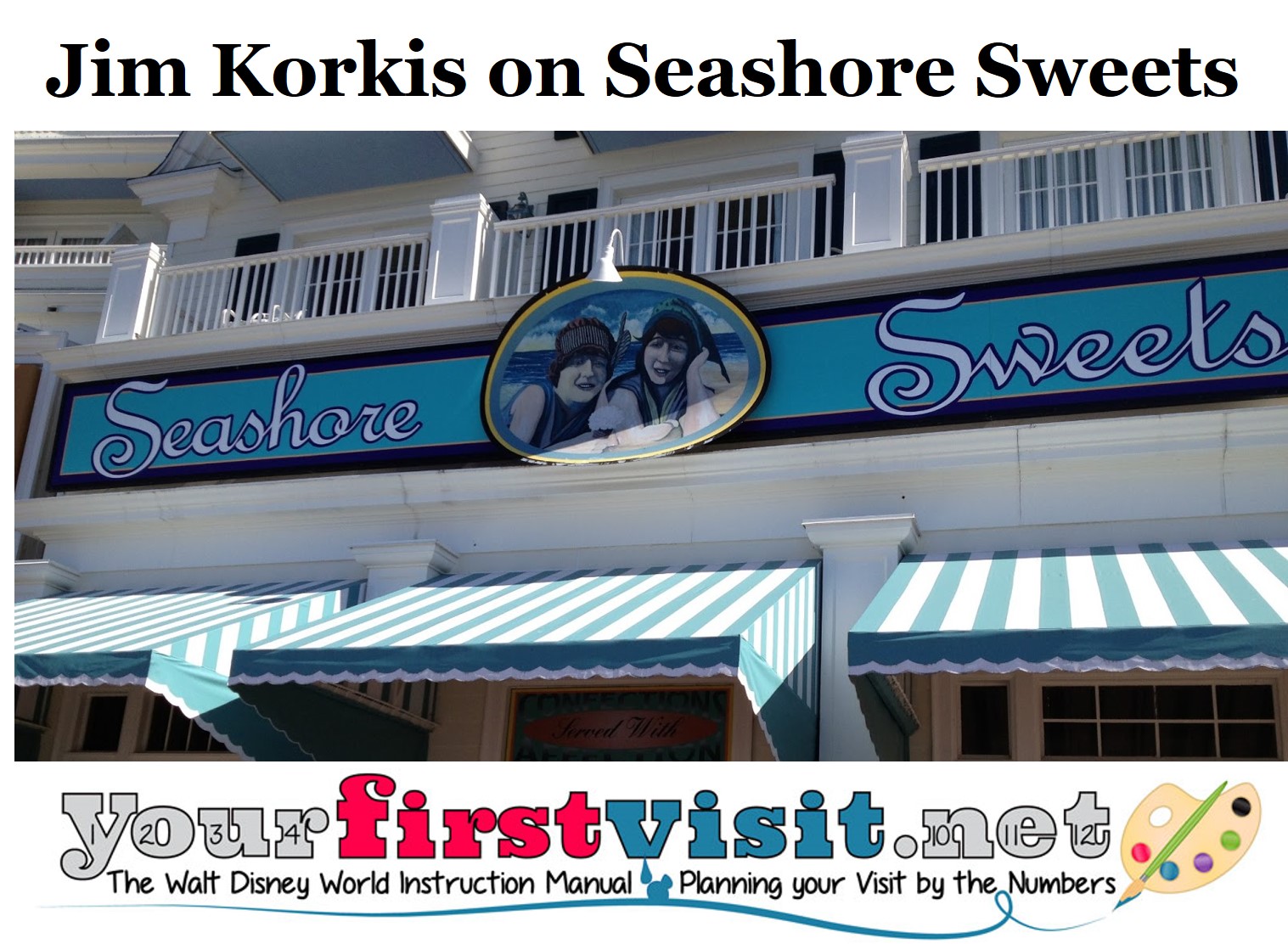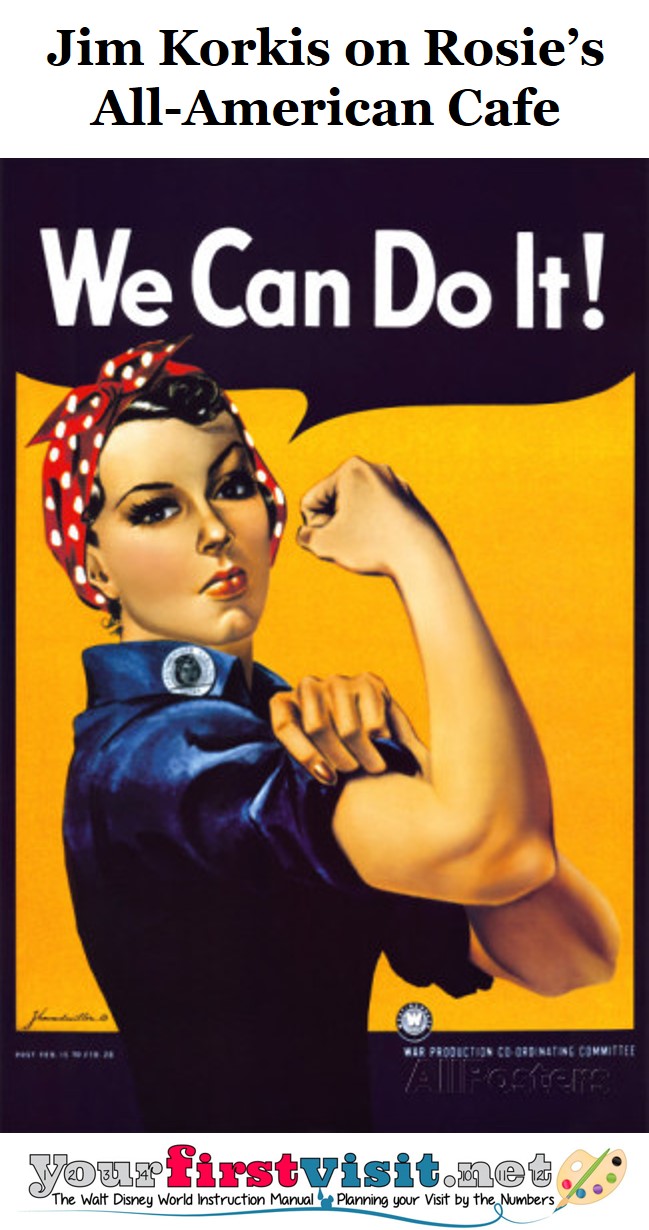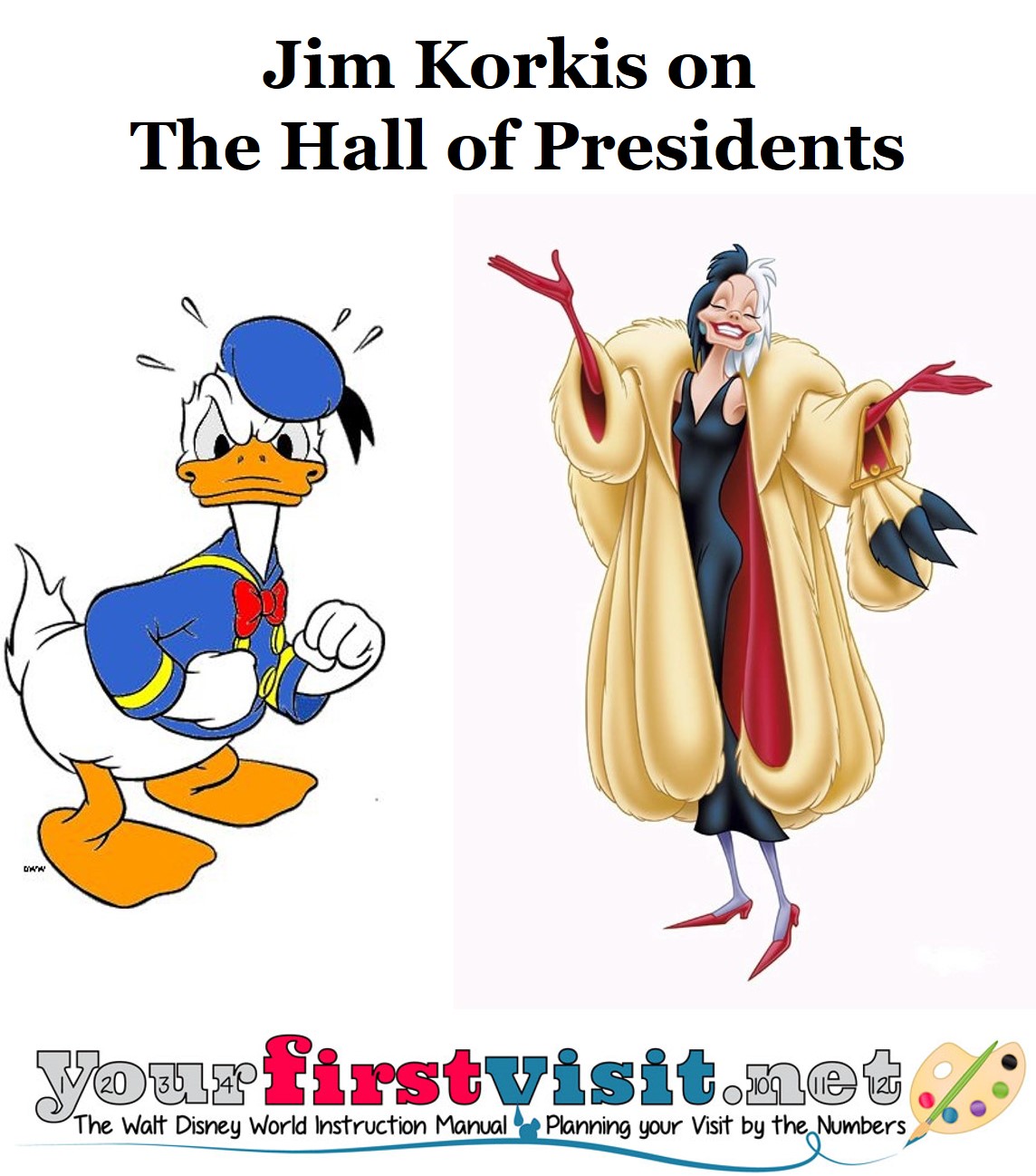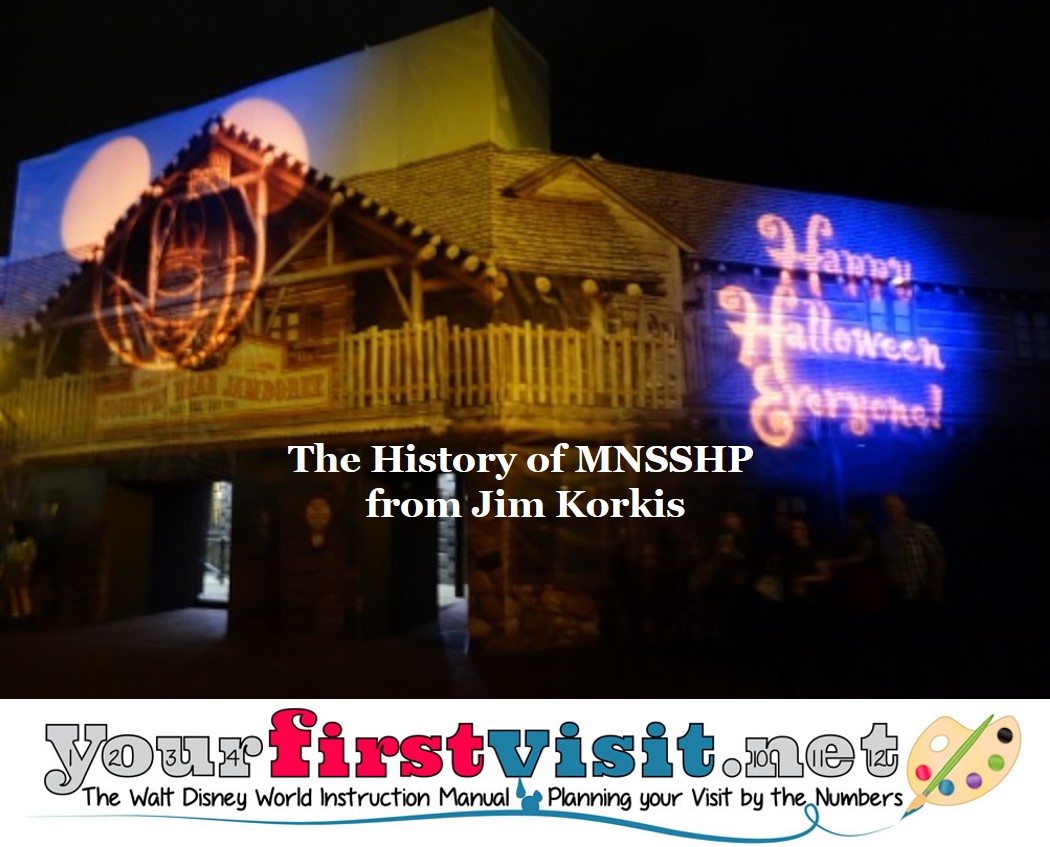Category — A Friday Visit with Jim Korkis
A Friday Visit with Jim Korkis: Charles Ridgway and the Opening of Magic Kingdom
Welcome back to Fridays with Jim Korkis! Jim, the dean of Disney historians and author of Jim’s Gems in The easy Guide, writes about Walt Disney World history every Friday on yourfirstvisit.net.
CHARLES RIDGWAY AND THE OPENING OF THE MAGIC KINGDOM
By Jim Korkis
As we celebrate this year the 45th anniversary of Walt Disney World, I am going to occasionally write about some of the early days of this vacation kingdom.
Charlie Ridgway was hired at Disneyland in January 1963 as a publicity man. In 1969 he was offered the job as Publicity Manager for Walt Disney World and re-located to Florida.
He helped launch the opening of Walt Disney World in 1971 and EPCOT Center in 1982 as well as special projects for celebrations such as Donald Duck’s 50th birthday in 1984. He retired in 1994 and was made a Disney Legend in 1999.
Here are some excerpts from an interview I did with him where he talks about that fabled opening day October 1, 1971.
“Well, we had had several ‘test’ groups come through the Magic Kingdom park before Opening Day and the press was starting to grumble because they wanted to see what was going on. They kept pushing me to see the park and I finally told them we would let them in Opening Day before we let in the guests and give them a tour and tell them how we were going to pick the first family, etc.
“I arranged for the news people to meet me at 6 a.m. on Friday, October 1st. We took them on a tour of the park including the utilidors with young people rushing past us to get to their location.
“Anyway, the only resort that had rooms completed was the Polynesian. It had something like 500 rooms and we had maybe 100 that were ready. We decided to have the press office there. The night of September 30th around ten or eleven o’clock, I was exhausted but I went over to see the progress on the room since we were expecting maybe 200 reporters. It was horrible. There were bare light bulbs hanging from the ceiling. No carpeting on the floor. No wallpaper. No phones.
“I just lost it. I blew up and told the crew that the reporters were coming the next morning and this room wasn’t even close to being finished. The crew boss told me to calm down and everything would be ready in time.
“I was staying at the Hilton Inn South on Sand Lake Road. The Disney Company had leased the place to train cast members that were going to work at the Contemporary and the Polynesian and that’s where they put up the Disney executives. I was going to wake up at 5:00 so that I would have plenty of time to be there before the media got to the Polynesian. I overslept.
“I woke up about ten minutes before 6:00am. I also had to check out that day so I was rushing to get dressed and pack. As I rushed through the lobby I literally threw my room keys 60 feet to the desk and gave them a piece of my mind for not waking me up on time. I didn’t properly check out and they still send me a bill to this day.
“So, I got to the press room and there were these beautiful chandeliers hanging down, and wall paper was up and carpet on the floor and all these tables and chairs and phones ringing off the hook. It was unbelievable. Newsmen were there drinking coffee and eating pastries and waiting for me to brief them. They had no clue what a disaster this area was just hours before.
“More than 600 other invited press came in groups of 100 on opening trips during the first three weeks of the Magic Kingdom opening. Planned luaus on the beach were rained out regularly but we pigged out in the Polynesian lobby and that was almost as much fun. We showed them everything and sent them home tired, happy and loaded with press kits.”
* * * * *
Thanks, Jim! And come back next Friday for more from Jim Korkis!
In the meantime, check out his books, including Secret Stories of Walt Disney World: Things You Never You Never Knew, which reprints much material first written for this site, and The Vault of Walt: Volume 4, and his contributions to The easy Guide to Your Walt Disney World Visit, all published by Theme Park Press.
Follow yourfirstvisit.net on Facebook or Google+ or Twitter or Pinterest!!
November 18, 2016 No Comments
A Friday Visit with Jim Korkis: Seashore Sweets
Welcome back to Fridays with Jim Korkis! Jim, the dean of Disney historians and author of Jim’s Gems in The easy Guide, writes about Walt Disney World history every Friday on yourfirstvisit.net.
SEASHORE SWEETS (AND FLYING FISH CAFE)
By Jim Korkis
To accommodate the new AbracadaBar on the BoardWalk, an old fashioned ice cream and candy shop called Seashore Sweets was closed February 1, 2016. The shop was especially known for offering hand-scooped ice cream.
The framed newspaper on the wall in the AbracadaBar has a small article in the lower right hand corner that does not talk about magicians but about the Sweet Sisters. This is just another clever touch by Imagineers to reference what was in the location previously. Here is that full back story that the article is alluding to in its coverage.
Seashore Sweets had a main story related to the Miss America Pageant that was celebrated throughout in this location and a smaller tangent story about a well-known candy associated with Atlantic City.
Atlantic City is where saltwater taffy was created in 1883 when a clever businessman named David Bradley sold some taffy that had a hint of salt water when his shop was flooded by ocean water.
A hint of salt water is not an ingredient in salt water taffy today. Of course, salt water taffy could be purchased in the shop, usually with Goofy’s face on the bag.
The main storyline was that two sisters, known as the “Sweet Sisters”, who competed in the early Miss America pageant decided to stay in the area and opened the shop. Their picture is on the outside sign and the motto of the store is “Confections served with Affection” (look for the heart shapes in the letter “O” in that sign).
Atlantic City was famous for the Miss America pageant that began in the 1920s and lasted for 85 years on the Boardwalk before relocating to Las Vegas in 2007. It returned to Atlantic City in 2013.
Leanza Cornett, who was Miss America 1993, was the first actress to play a live-action version of Ariel, the title character from The Little Mermaid, at the Voyage of The Little Mermaid show at Disney’s Hollywood Studios at Walt Disney World Resort in 1991.
There were many authentic artifacts like souvenir programs and tickets inside the store including in a transparent case on the right hand side of the entrance with a trophy, crown, regal cape and scepter used in an actual Miss America pageant.
Up above near the ceiling were framed photos of all the Miss America winners from 1921 through 2007 (when it stopped being held in Atlantic City).
In the earliest days, the women were not just judged in a swimsuit competition (called the Bathers’ Revue) but also as part of the Rolling Chair Parade, referenced in that newspaper article on the wall.
Framed posters and memorabilia could be found in every area of the small shop. A souvenir program from the 1942 pageant would have cost twenty-five cents that year but is worth many times that price today.
The inspiration for the name Flying Fish Café next door most likely came from a classic Coney Island roller coaster called the Flying Turns. One of the ride vehicles on that coaster was called the Flying Fish.
The interior of the restaurant was originally a colorful homage to Coney Island. The back of the booths resembled the curving lifts and drops of a roller coaster. On the back wall was a huge depiction of a back-lit Ferris wheel.
Fish did, in fact, fly overhead in pairs on a version of the famous parachute ride that was a decades-long favorite at Steeplechase Park at Coney Island. In fact one of the first images on the wall mural is of people riding the eight wooden horses on a steel track at Steeplechase.
On the cloud painted ceiling, the stars changed colors every few minutes.
The entire interior, including the addition of an open on-stage kitchen, has been recently redesigned. The new design includes images of flying fish in a chandelier of glass, the kitchen tiles and the upholstery. The restaurant also has references to the classic boardwalk with carnival art, vintage carnival games and more.
* * * * *
Thanks, Jim! And come back next Friday for more from Jim Korkis!
In the meantime, check out his books, including Secret Stories of Walt Disney World: Things You Never You Never Knew, which reprints much material first written for this site, and The Vault of Walt: Volume 4, and his contributions to The easy Guide to Your Walt Disney World Visit, all published by Theme Park Press.
Follow yourfirstvisit.net on Facebook or Google+ or Twitter or Pinterest!!
November 11, 2016 No Comments
A Friday Visit with Jim Korkis: Rosie’s at Disney’s Hollywood Studios
Welcome back to Fridays with Jim Korkis! Jim, the dean of Disney historians and author of Jim’s Gems in The easy Guide, writes about Walt Disney World history every Friday on yourfirstvisit.net.
ROSIE’S ALL AMERICAN CAFE
By Jim Korkis
During World War II, the term “Rosie the Riveter” was created by the government to represent the many patriotic women who took temporary jobs “making history working for victory” on the assembly lines of various industries to free up men needed in the military.
That image and distinctive name was portrayed in posters, magazine covers and even a popular 1942 song recorded by multiple artists.
Rosie’s All American Café is an homage to this well-known feminist icon. Part of the Sunset Ranch Market area in Disney’s Hollywood Studios, Rosie is depicted in the Café on the sign as a smiling redheaded welder heating up a frying pan which is meant to imply that she has experience handling flames and is a good cook.
The interior of the quick serve location is decorated with some authentic World War II memorabilia alongside some “Imagineered” items relating to the fictional life of the woman owner.
Several signs including “Keep ‘Em Flying”, “V for Victory” and “Stay True to the Red, White and Blue” adorn the outside. Even the outside condiment bar is topped by a glass enclosed case featuring metal toy soldiers and other authentic artifacts from the 1940s.
Since it is “All American”, it offers the traditional American food offerings of hamburgers, fries and a Coke.
On the side of the building is a large colorful item that is not only a reference to World War II but to the Disney Studio participation during the conflict. Over the course of the war, the Disney Studio designed roughly twelve hundred different military insignia free of charge for all branches of the United States armed forces.
Under the supervision of artist Hank Porter who did most of the designs, a team of five artists did the work. In October 1941, the Disney Studio created the famous insignia for General Chennault’s legendary American Volunteer Group, Chinese Air Force, better known as the Flying Tigers.
The original rough design was done by Roy “Big Mooseketeer” Williams and finished by Porter. It featured a winged tiger springing upward against a background letter “V” standing for “Victory”. That early insignia is displayed on the side wall.
Additional Disney created insignia including those featuring Mickey Mouse, Donald Duck and a Gremlin are on the interior of the café.
Nearby is Rosie’s Victory Garden, a familiar site during the war years when growing vegetables, fruits and herbs in a private garden for home use helped free up supplies so that the government could send more of these items from farms to feed men in the military.
Rosie uses her garden to supply some of the food for her service counter. Real items like cabbage, mustard, beans, peppers and corn grow in the garden and change out over the different seasons.
Imagineering was faced with the sensitive challenge of how to create an accurate depiction but avoid any derogatory references to specific nationalities that were involved in the war just as they did in the American Adventure attraction at Epcot.
The scarecrow wears an old U.S. flight suit including goggles, helmet, oxygen mask and inflatable yellow life vest from Rosie’s boyfriend who is still serving his country as a pilot overseas according to memorabilia inside the café. This figure was meant to scare off unpatriotic birds who might pillage the small garden of its bounty.
The sign proclaims “Victory With Vegetables” and above it are three dots and a dash, which were the opening notes of Beethoven’s Fifth Symphony. Five in Roman numerals is “V”. At the bottom it declares “Rosie’s Victory Garden”.
In addition, there is an Uncle Sam wind spinner whose unpredictable movement is also meant to scare away pests. Rosie’s garden tools are hanging along the side of the Catalina Eddie building right next to the garden.
* * * * *
Thanks, Jim! And come back next Friday for more from Jim Korkis!
In the meantime, check out his books, including Secret Stories of Walt Disney World: Things You Never You Never Knew, which reprints much material first written for this site, and The Vault of Walt: Volume 4, and his contributions to The easy Guide to Your Walt Disney World Visit, all published by Theme Park Press.
Follow yourfirstvisit.net on Facebook or Google+ or Twitter or Pinterest!!
November 4, 2016 No Comments
A Friday Visit with Jim Korkis: Voices in the Hall of Presidents
Welcome back to Fridays with Jim Korkis! Jim, the dean of Disney historians and author of Jim’s Gems in The easy Guide, writes about Walt Disney World history every Friday on yourfirstvisit.net.
TALKING PRESIDENTS AND ONE TO COME
By Jim Korkis
Every U.S. President since Harry Truman, with the exception of Lyndon Johnson, has visited a Disney theme park. Of course, every president since George Washington is represented in the Hall of Presidents at the Magic Kingdom.
With the upcoming election and a new president in office soon, many Disney fans are wondering when that head of state will make its appearance in the attraction, especially since Disney now outsources all audio-animatronics to Garner Holt.
Beginning in 1993, an audio-animatronics representation of the current sitting President of the United States speaks as part of the finale. The actual presidents recorded their presentations at the White House under the supervision of WDW Imagineers. Amazingly, in almost twenty-five years, there has only been the need to do so three times. Here are those speeches:
Bill Clinton in The Hall of Presidents:
My fellow citizens, we are the heirs of the great American Revolution. As this millennium draws to a close and the 21st century approaches, let us pause to honor the very idea of America. America mirrors the world’s diversity, yet it remains united in the struggle to uphold fundamental freedoms. We believe our nation’s happiness still evolves from liberty, from opportunity and from the vision of equality set forth by our country’s Declaration of Independence. And today our nation stands as a symbol of freedom and inspiration to people all over the world.
There is nothing wrong with America that cannot be cured by what is right with America. And there is nothing wrong with the world that cannot be cured by the ideals that America represents. Those principles have no borders, and we look forward to a day when those principles, extended beyond our borders, will have circled the globe. The quest for democracy must continue until all of the people of the world enjoy the freedom we must always fight to preserve. The spirit of America is as bright and hopeful today as it was in July of 1776. And we are ready to carry our great national experiment forward into the next millennium.
George W. Bush in The Hall of Presidents:
My fellow Americans, when we look back on the history of this country, we see a record of almost unbelievable energy, sacrifice, hard work; of impossible dreams that our ancestors dreamed and made real. We see injustice, too, that weighs on our hearts even today. But for every injustice there has always been a voice crying out to right it. And America has always listened to those voices. We are listening today. And perhaps it falls to us, to this first generation of 21st century Americans, to say, once and for all, that no child, no race, no creed, no ethnic community will ever again be left out of the American dream.
Through education, through the opportunity to work and to enjoy the fruits of that work, we can open every closed door, expand the horizons of all Americans. Again and again, we return to the same simple principles: freedom, equality. The freedom to create, to prosper, to dream. Equality before the law, in the workplace, and a chance for a better life. And each time, in the process, America grows stronger. The beacon of democracy grows brighter. The world looks with new astonishment at what free people can do. We the people are just getting started.
Barack Obama in The Hall of Presidents:
The American dream is as old as our founding, but as timeless as our hopes. It is reborn every day in the heart of every child who wakes up in a land of limitless possibilities, in a country where “we, the people” means all the people. We may come from different places and believe different things, but what makes us American is a shared spirit; a spirit of courage and determination; of kindness and generosity. It is a spirit grounded in the wisdom of the generations that have gone before us, but open to the unimagined discoveries and possibilities on the horizon that lies ahead. Let us enjoy it, cherish it, defend it, and pass it on to our children as the bright and beautiful blessing it is: this enduring American dream.
* * * * *
Thanks, Jim!
At least to me, it’s a bit interesting that with these candidates, The Hall of Presidents will become a scary ride!
And if–as is appropriate–you don’t care what I think about the election, then just come back next Friday for more from Jim Korkis!
In the meantime, check out his books, including Secret Stories of Walt Disney World: Things You Never You Never Knew, which reprints much material first written for this site, and The Vault of Walt: Volume 4, and his contributions to The easy Guide to Your Walt Disney World Visit, all published by Theme Park Press.
Follow yourfirstvisit.net on Facebook or Google+ or Twitter or Pinterest!!
October 28, 2016 No Comments
A Friday Visit with Jim Korkis: The Secret History of Churros
Welcome back to Fridays with Jim Korkis! Jim, the dean of Disney historians and author of Jim’s Gems in The easy Guide, writes about Walt Disney World history every Friday on yourfirstvisit.net.
THE SECRET ORIGIN OF CHURROS
By Jim Korkis
In the January 5, 2003 episode of The Simpsons (Season 14, Episode 298 “Special Edna”), Homer escapes Epcot to get into the Magic Kingdom and asks for one churro from a vendor that costs fourteen dollars.
In real life, the fried dough pastry still costs a hefty $3.50 considering it is made with just inexpensive dough, sugar and cinnamon.
Churros are much more prevalent in California’s Disneyland but can also be found at Walt Disney World in locations like the Cantina de San Angel at the Epcot Mexico pavilion and the food court at Coronado Springs Resort among other places.
In 1985, the man responsible for food and beverage in Disneyland’s Fantasyland was Jim Lowman. With the scheduled opening of a new dance location for young people called Videopolis, he needed to bring in something new and unique to offer them.
That same year he attended the Long Beach Grand Prix event and saw his first churro booth and that all that was needed was a small warming oven. Snooping around, he found an empty box from J & J Snack Foods. The treat seemed popular, inexpensive, easy to produce and something out-of-the-ordinary.
He later phoned the company to see if they might be interested in working with Disneyland. However, to make the churro a unique Disneyland churro and to increase the price that they could be sold for to hungry teenagers, Lowman insisted that they enlarge the size from six inches to twelve inches.
Lowman decided to do a little test before Videopolis opened. He felt the treat would theme in with Frontierland and its Mexican food influences so he stationed a small cart by the exit of the Mark Twain Riverboat. Even as the cart was rolling to that location, it was followed by at least thirty people who were entranced by the smell.
Just at that one temporary location, sales were constant for the next two weeks straight. When Videopolis opened, two churro carts were placed there and again, became so popular that the carts were expanded to other areas.
Originally the warming ovens, like the traditional one that Lowman first saw, were propane powered and that created a problem. Because of the popularity of the treat, even with six full propane tanks in each cart, they would run out, often by midday and had to be replaced. Of course, propone is also explosive.
By the end of the first summer, the propane was replaced with electricity. The carts became part of Disneyland’s Outdoor Vending Team, the same group that sells popcorn and ice cream around the park.
When asked about the seemingly exorbitant price for a little bit of cinnamon and sugar like a doughnut, Lowman, who has been working at Disneyland for fifty years, proposes that guests get so many things for free like fireworks, clean restrooms and live entertainment that those items have to be paid for in other ways.
“It’s either low food prices and pay to watch shows and watch entertainment, or higher food prices so that all of that can be wrapped up into one,” he told an interviewer in 2015.
He is constantly on the look-out for new food items including the barbecue foods and skewers he brought to Bengal Barbecue located near the Indiana Jones attraction at Disneyland.
“That’s the fun of restaurant management,” Lowman said, “You can look at county fairs, you can look at different restaurants, you can look at what’s sold in grocery stores and think, ‘How can that translate to my business?’”
* * * * *
Thanks, Jim! And come back next Friday for more from Jim Korkis!
In the meantime, check out his books, including Secret Stories of Walt Disney World: Things You Never You Never Knew, which reprints much material first written for this site, and The Vault of Walt: Volume 4, and his contributions to The easy Guide to Your Walt Disney World Visit, all published by Theme Park Press.
Follow yourfirstvisit.net on Facebook or Google+ or Twitter or Pinterest!!
October 21, 2016 1 Comment
A Friday Visit with Jim Korkis: Mickey’s Not So Scary Halloween Party
Welcome back to Fridays with Jim Korkis! Jim, the dean of Disney historians and author of Jim’s Gems in The easy Guide, writes about Walt Disney World history every Friday on yourfirstvisit.net.
THE HISTORY OF THE MAGIC KINGDOM HALLOWEEN PARTY
By Jim Korkis
Mickey’s Not So Scary Halloween did not exist when the Magic Kingdom opened but two highly popular events inspired its creation.
The very first Mickey’s Very Merry Christmas Party was held on December 16, 1983 for one night only but then expanded to two nights in 1989, then three nights in 1990 and its popularity continued to increase so that today, it runs for multiple weeks.
This separate hard ticketed event offered to a limited number of guests after the Magic Kingdom closed for the night was a great guest satisfier with new things added to it each year.
Halloween Horror Nights began at Universal Studios Florida in 1991 for three nights and was instantly popular so that today, it also runs for multiple weeks. Designed as the ultimate in an interactive scary experience, it sparked the creation of similar events at amusement venues not only in Central Florida but also in Southern California.
The Disney Company decided that perhaps a family friendly alternative celebration to the Universal event along the same lines as the MVMCP might appeal to people. Those holiday offerings were generating tens of thousands of additional sales from theme park guests and local residents.
WDW has previously experimented with some small Halloween themed promotions as early as 1972 but most often in the individual resorts. In 1975 to help attract locals and guests to the new Lake Buena Vista Shopping Village, the Village Halloween Party was introduced where children (encouraged to attend in costume) could go with their parents trick-or-treating at the various stores and restaurants.
Another experiment was the one night separate ticketed Halloween Hysteria event at the Magic Kingdom held after operating hours in 1979. It wasn’t until October 31, 1995 that the first Mickey’s Not So Scary Halloween Party debuted. Like the first year of MVMCP, it was held for only one night to determine if there was any interest. The cost was $16.95.
By October 1997, it increased to two nights and in 1999 increased again to three nights. Two years later in 2001, it grew to five nights and two years after that in 2003 to ten nights. By 2005, it was boosted to fifteen nights and in 2016 there were twenty-nine nights. Just like MVMCP, new offerings were introduced each year.
Depending upon which night an adult attends, today, it can cost between seventy-two dollars and more to over a hundred dollars on Halloween night.
There are many reasons for the popularity of the event. First, it provides a safer and more magical environment for young children to go trick-or-treating for quality candy than visiting their local neighborhoods. Second, the limited number of people in the park provides easier access to favorite attractions.
Finally, during the event, the Magic Kingdom provides some unique experiences that don’t exist normally from a special “Mickey’s Boo To You” parade to eerie projections on the castle and unique stage shows in addition to Disney character dance parties.
Since 2005, the event includes an exclusive fireworks show titled Happy HalloWishes: A Grim Grinning Ghosts’ Spooktacular in the Sky with Halloween themed music. In addition, several limited edition merchandise from pins to ornaments to apparel are sold.
Of course, one of the key components is the opportunity to get free candy at a variety of locations. In 2016, roughly 285 tons of candy will be handed out during all the parties including 40 different kinds of brand-name candies, including Snickers, Milky Way, Butterfingers, M&Ms and Kit Kats as well as other offerings. Allergen free candy is also available so that children with allergies can still participate.
* * * * *
Thanks, Jim! For 2016 party dates see this, and for a review of the 2016 Mickey’s Not-so-Scary Halloween Party, see this! And come back next Friday for more from Jim Korkis!
In the meantime, check out his books, including Secret Stories of Walt Disney World: Things You Never You Never Knew, which reprints much material first written for this site, and The Vault of Walt: Volume 4, and his contributions to The easy Guide to Your Walt Disney World Visit, all published by Theme Park Press.
Follow yourfirstvisit.net on Facebook or Google+ or Twitter or Pinterest!!
October 14, 2016 No Comments








